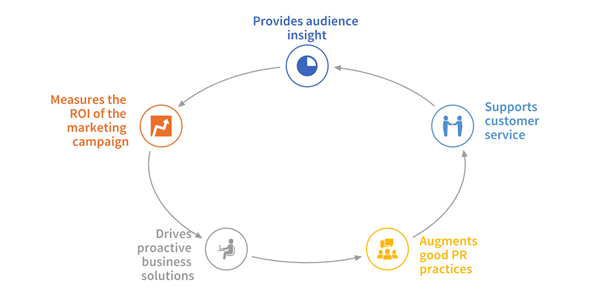Blog
Sentiment Analysis is difficult, but AI has an answer
- Importance of Sentiment Analysis
- Types of AI enabled Sentiment Analysis
- Challenges and Pitfalls
The study of people’s emotions and opinions based on clues in their language is known as sentiment analysis. At first sight, it seems to be merely a question of text classification, but a closer study shows several dynamic issues that have a profound effect on the accuracy of the sentiment analysis.
Importance of Sentiment Analysis

We might underestimate the power of text, but it provides sellers with accurate feedback. If you want to understand people more, you need to analyze their sentiments through their text. Humans are trained for the ability naturally; however, now we have tools analyzing text for companies to read people’s sentiments and judge the product’s value. The figure above is explaining the cycle and the way it works for the companies quite precisely.
So, how does it work? To understand the mechanism behind this, we need to understand the different sentiment analysis types
Types of AI enabled Sentiment Analysis
Although the most common form of sentiment analysis focuses on polarity (classifying an opinion as positive, negative, or neutral), other styles may concentrate on detecting feelings, emotions, or intentions. Some of the applications with the sentiment analysis types are:
- Social media monitoring
- Customer support
- Customer feedback
- Brand monitoring and reputation management
- Voice of Customer (VOC)
- Voice of employee
- Product analysis
- Market research and competitive research
How AI is simplifying Sentiment Analysis?
Sentiment analysis serves as a guide to AI-powered text analysis. Sentiment analysis is one of the first moves for any enterprise or data scientist to derive meaning from an unstructured text corpus. It provides a high ROI of additional insights with a relatively low expenditure of time and effort. With an abundance of text data in digital formats, the demand for sentiment analysis and other NLU techniques for analyzing this data is increasing. Sentiment Analysis appears to be relatively easy and works well today, but we arrived here after considerable research efforts who pioneered various methods and tested multiple models.
It started from the models like:
- Recurrent Neural Network -RNN Models
- Recursive Neural Tensor Network – RNTN Models
- Attention-Based Neural Networks – ABNN Models
- Multi-Task Learning – MTL Models
- Convolutional Neural Networks – CNN Models
- Unsupervised Sentiment Neuron – USN Models
- Non-Neural Networks Based Models – NNB models
With the extensive and ongoing research on these models, the accuracy of sentiment analysis and classification tasks is destined to improve.
Challenges and Pitfalls of Sentiment Analysis
It may seem simple to detect the text and its sentiments. But if we dig deeper, many challenges still need to be addressed by professionals and researchers.
Some of the challenges, AI based sentiment analysis is facing are:
Sarcasm Detention
It’s difficult to effectively train sentiment analysis models due to the endless variance in the terms used in sarcastic sentences. To make sarcasm accessible, two people must share common subjects, interests, and historical facts. Besides this, there are also various types of sarcasm, and detecting all of them can be hard.
Elisabeth Camp, an author and professor of Philosophy categorises sarcasm into the following types:
- Proportional
- Embedded
- Like-prefixed
- Illocutionary
So, researchers are working on different methods like deep learning, machine learning algorithms, rule-based and statistical techniques. Deep learning has shown some improvements; however, other methods may still need a different approach to make it work.
Negation Detection
Negation is a process of reversing the polarity of words, phrases, and even sentences in linguistics. Researchers use several linguistic rules to decide whether negation is taking place, but it’s also important to determine what words are influenced by negation words.
Many state-of-the-art sentiment analysis methods use the easiest method for dealing with negation in a sentence: to label all the terms from a negation cue to the next punctuation token as negated. The models can vary in negation detection, and is an active NLP research topic.
Word Ambiguity
While you are dealing with sentiment analysis, you will come across the word ambiguity too. Polarity is dependent on the context of the sentence, and if it is not clear, it is hard to detect. Lexicon is the emotion-based method, and word polarity varies in different domains; therefore, we need a universal opinion lexicon to be a little more obvious about the detection of opinion based on the right emotion.
Multipolarity
If you are a reader or even a researcher, you will understand multipolarity. It exists when the author talks about different things. They have mixed emotions like something is great and something is not as amazing as they anticipated. Many tools that we have for sentiment analysis still lack the detection of multipolarity. Researchers suggest that the model should analyze each sentence in a review or feedback and assign polarity to one sentence at a time.
Bottom Line
Sentiment analysis is difficult, but AI has an answer. By using natural language processing and machine learning algorithms, we can overcome many of the limitations of traditional sentiment analysis methods. Due to this advancement, businesses now have access to a much more accurate understanding of customer sentiment.
At Aegasis Labs, we have world-class ML Engineers dedicated to building Sentiment Analysis solutions. Our ML Engineers can build bespoke sentiment analysis system based on your business needs. If you would like to learn more then schedule a free consultation call today.
